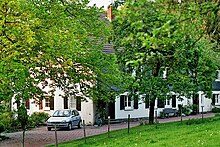Hugenbruch
|
Hugenbruch
City of Wuppertal
Coordinates: 51 ° 16 ′ 55 ″ N , 7 ° 6 ′ 0 ″ E
|
||
|---|---|---|
| Height : | 208 m above sea level NHN | |
| Incorporation : | 1975 | |
|
Location of Hugenbruch in Wuppertal |
||
|
Lowest Hugenbruch in winter
|
||
Hugenbruch is a court in the Wuppertal residential area of Eckbusch in the Uellendahl-Katernberg district .
geography
The farm is at 208 m above sea level. NHN at Kreisstraße 22 between the Bergische Diakonie Aprath and the local border hunting lodge . The Eigenbach , a tributary of the Düssel , flows north past the Hofschaft. Neighboring places are in addition to Eigen the farms Auf dem Hufen , Oberste- and Unterste Leimberg , Zum Löh and the comparatively dense settlement in the area of the outdoor pool Eckbusch.
etymology
The name translated means toad swamp and is derived from the Old High German Hugen = toads and Bruch = swamp . The decisive factor was the (now largely drained) swampy soils on the banks of the Eigenbach, which were a preferred habitat for toads.
history
In the 17th century, the Hugenbruch farm belonged to the allodial property of the Lords of Aprath Castle . Administratively, he belonged to the Oberdüssel Honschaft in the area of the Bergische Unterherrschaft Schöller . After the dissolution of the Grand Duchy of Berg in 1813, Hugenbruch was part of the Oberdüssel district in the mayor's office and later town of Wülfrath .
The court is recorded as Hugenbruck on the sheet Dominium Schöller of the Topographia Ducatus Montani by Erich Philipp Ploennies from 1715, the map of the Duchy of Berg by Carl Friedrich von Wiebeking from 1789 mentions the same spelling. There, however, the farm is assigned to the area of the Bergische Unterherrschaft Hardenberg . Today's Kreisstraße 22 ( Oberdüsseler Weg ) through the courtyard is recorded for the first time on the topographical survey of the Rhineland from 1824. It is also the street that divides the Hofschaft into the northern Unterste Hugenbruch and the southern Oberste Hugenbruch . Both names can also be found on the Prussian first recording from 1843.
According to the community dictionary of the Kingdom of Prussia , Hugenbruch owned two houses with twelve inhabitants in 1888. When Elberfeld , Barmen and other cities merged into Wuppertal in 1929 , the western part of the Oberdüssel area was assigned to Hugenbruch Elberfeld and so came to Wuppertal.
At the beginning of the 20th century there was an inn in Hugenbruch called Haus Hugenbruch (later: Haus am Waldsee ), at this time a large reservoir was created on the Eigenbach, which was used as a barge pond. The Elberfeld Pastor Dr. Paul Erfurth bought the neighboring Gut Eigen in 1908 in order to establish a rural branch of the " Elberfeld-Barmer rescue and refuge houses for needy single women " (today's Bergische Diakonie Aprath ). After the construction and occupation of the Eben Ezer house on Gut Eigen in 1910 by Elberfeld “welfare children”, he also acquired the nearby Hugenbruch house in 1914 and set up another refuge there for “ 20 female weak-minded women ”.
The best-known son of the village is the writer Carl Schmachtenberg , who spent most of his life on the Unterste Hugenbruch farm.
Individual evidence
- ^ Hermann Kießling: Courtyards and farm associations in Wuppertal. Bergisch-Märkischer Genealogischer Verlag, Wuppertal 1977.
- ↑ Historical maps: Topographia Ducatus Montani by Erich Philipp Ploennies from 1715; Carte of the Duchy of Berg of the Carl Friedrich von Wiebeking from 1789; Topographical recording of the Rhineland from 1824, Prussian new recording and Prussian first recording (last three on: Historika25, Landesvermessungsamt NRW, sheet 4708, Elberfeld)
- ↑ Königliches Statistisches Bureau (Prussia) (Ed.): Community encyclopedia for the Rhineland Province, based on the materials of the census of December 1, 1885 and other official sources, (Community encyclopedia for the Kingdom of Prussia, Volume XII), Berlin 1888.
- ^ Volkmar Wittmütz: 100 years of Bergische Diakonie Aprath. "Give up nobody and nothing" (= series of publications by the Association for Rhenish Church History. Vol. 69). Rheinland-Verlag et al., Cologne et al. 1982, ISBN 3-7927-0688-1 .


